Lexus RX (RX 350L, RX450h) 2016-2025 Repair Manual: Precaution
PRECAUTION
CAUTION:
-
The fuel tank assembly is very heavy. Be sure to follow the procedure described in the repair manual, or the fuel tank assembly may fall off the engine lifter.
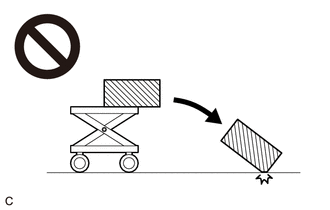
-
To prevent serious injury due to fuel spray from the high-pressure fuel lines, always discharge fuel system pressure before removing any fuel system components.
.png)
BEFORE WORKING ON FUEL SYSTEM
(a) Before inspecting and repairing the fuel system, disconnect the cable from the negative (-) battery terminal.
NOTICE:
After turning the engine switch off, waiting time may be required before disconnecting the cable from the negative (-) battery terminal. Therefore, make sure to read the disconnecting the cable from the negative (-) battery terminal notices before proceeding with work.
Click here .gif)
.gif)
(b) Do not smoke or work near fire when handling the fuel system.
(c) Keep fuel away from rubber or leather parts.
DISCHARGE FUEL SYSTEM PRESSURE
CAUTION:
- Make sure the engine coolant temperature is 60°C (140°F) or less when performing this procedure.
- Do not disconnect any part of the fuel system until you have discharged the fuel system pressure.
- Pressure will still remain in the fuel lines even after performing the following procedure. When disconnecting a fuel line, cover it with a piece of cloth to prevent fuel from spraying or coming out.
(a) When discharging fuel system pressure by disconnecting the FUEL PMP relay:
(1) Remove the No. 1 engine room relay block and No. 1 junction block assembly cover.
(2) Remove the FUEL PMP relay.
(3) Remove the V-bank cover sub-assembly.
Click here .gif)
.gif)
(4) Disconnect the No. 6 engine wire connector and No. 7 engine wire connector.
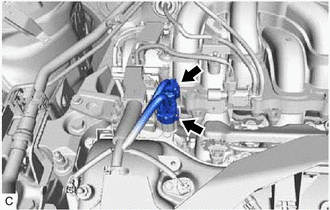
(5) Start the engine. After the engine has stopped on its own, turn the engine switch off.
NOTICE:
Do not increase the engine speed or drive the vehicle while waiting for the engine to stop on its own.
(6) Crank the engine again and make sure that the engine does not start.
HINT:
DTC P008700 (Fuel Rail / System Pressure - Too Low), P017100/P017400 (System Too Lean), P160300 (Engine Stall History), P160400 (Startability Malfunction) or P160500 (Rough Idling) may be stored. Clear the DTCs before proceeding to the next step.
Click here .gif)
(7) Remove the fuel tank cap assembly and discharge the pressure from the fuel tank assembly.
(8) Disconnect the cable from the negative (-) battery terminal.
NOTICE:
When disconnecting the cable, some systems need to be initialized after the cable is reconnected.
Click here .gif)
.gif)
(9) Connect the No. 6 engine wire connector and No. 7 engine wire connector.
(10) Install the V-bank cover sub-assembly.
Click here .gif)
.gif)
(11) Install the FUEL PMP relay.
(12) Install the No. 1 engine room relay block and No. 1 junction block assembly cover.
(b) When discharging fuel system pressure by disconnecting the fuel pump connector:
(1) Disconnect the fuel pump connector.
-
for TMC Made:
Click here
.gif)
.gif)
-
for TMMC Made:
Click here
.gif)
.gif)
(2) Remove the V-bank cover sub-assembly.
Click here .gif)
.gif)
(3) Disconnect the No. 6 engine wire connector and No. 7 engine wire connector.

(4) Start the engine. After the engine has stopped on its own, turn the engine switch off.
NOTICE:
Do not increase the engine speed or drive the vehicle while waiting for the engine to stop on its own.
(5) Crank the engine again and make sure that the engine does not start.
HINT:
DTC P008700 (Fuel Rail / System Pressure - Too Low), P017100/P017400 (System Too Lean), P160300 (Engine Stall History), P160400 (Startability Malfunction) or P160500 (Rough Idling) may be stored. Clear the DTCs before proceeding to the next step.
Click here .gif)
(6) Remove the fuel tank cap assembly and discharge the pressure from the fuel tank assembly.
(7) Disconnect the cable from the negative (-) battery terminal.
NOTICE:
When disconnecting the cable, some systems need to be initialized after the cable is reconnected.
Click here .gif)
.gif)
(8) Connect the No. 6 engine wire connector and No. 7 engine wire connector.
(9) Install the V-bank cover sub-assembly.
Click here .gif)
.gif)
(10) Connect the fuel pump connector.
-
for TMC Made:
Click here
.gif)
-
for TMMC Made:
Click here
.gif)
FUEL LINE
(a) When disconnecting a high-pressure fuel line, a large amount of fuel will spray. Perform the following procedure:
(1) Discharge fuel system pressure.
(2) Disconnect the fuel tube.
(3) Drain the fuel remaining inside the fuel pump tube into a container.
(4) Cover the disconnected fuel pipe and fuel tube connector with plastic bags to prevent damage and contamination.
(b) Quick Type A:
Perform the following procedure when disconnecting a fuel tube connector.
NOTICE:
Remove any foreign matter on the fuel tube connector and fuel pipe before performing this work.
.png)
(1) Remove the No. 2 fuel pipe clamp from the fuel tube connector.
(2) Check that there is no foreign matter around the fuel tube connector before disconnecting it. Clean it if necessary.
(3) While holding the retainer at the positions shown in the illustration, pull up the retainer to disengage the lock claws.
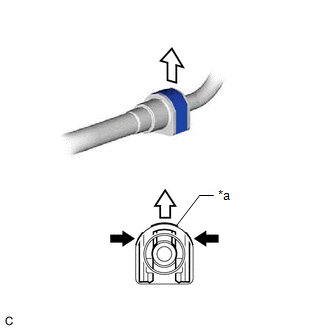
| *a | Retainer |
.png) | Retainer Holding Position |
.png) | Pull out |
HINT:
If the lock claws of the retainer are difficult to disengage, disengage them using a screwdriver with its tip wrapped with protective tape.
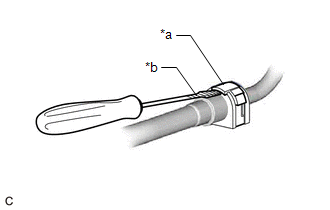
| *a | Retainer |
| *b | Protective Tape |
(4) Pull up the retainer while holding it at the positions shown in the illustration and pull off the fuel tube connector.
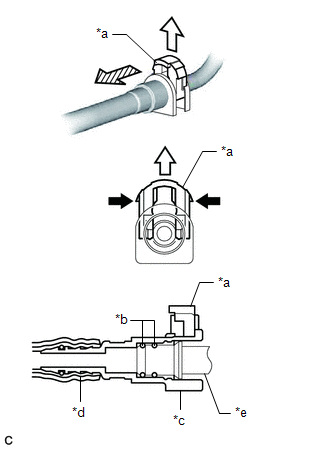
| *a | Retainer |
| *b | O-ring |
| *c | Fuel Tube Connector |
| *d | Nylon Tube |
| *e | Fuel Pipe |
.png) | Retainer Holding Position |
.png) | Pull out |
.png) | Pull off |
(5) If the fuel tube connector and fuel pipe are stuck, push and pull the fuel tube connector to release it. Pull the fuel tube connector off of the fuel pipe carefully.
NOTICE:
- Do not scratch or allow any foreign matter to get on the parts when disconnecting them as the fuel tube connector has O-rings that seal the pipe (fuel pipe).
- Do not bend, twist, pinch or kink the nylon tube.
(6) Check that there is no foreign matter on the sealing surfaces of the disconnected fuel lines. Clean them if necessary.
(7) Cover the disconnected fuel pipe and fuel tube connector with plastic bags to prevent damage and contamination.
(c) Quick Type A:
Perform the following procedure when connecting a fuel tube connector.
NOTICE:
Check that there is no damage or foreign matter on the connecting parts of the fuel lines.
(1) Align the fuel tube connector with the fuel pipe, push the fuel tube connector onto the fuel pipe, then push in the retainer to secure the connection.
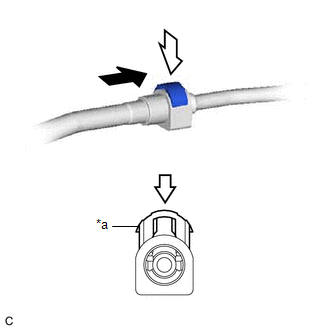
| *a | Retainer |
.png) | Push |
.png) | Push in |
NOTICE:
Confirm that the retainer makes a "click" sound when pushed.
HINT:
If it is difficult to push the fuel tube connector onto the fuel pipe, apply a small amount of clean gasoline to the tip of the fuel pipe.
(2) After connecting the fuel lines, check that the fuel pipe and fuel tube connector are securely connected by pulling on them.
(3) Install the No. 2 fuel pipe clamp to the fuel tube connector.
(4) Inspect for fuel leaks.
Click here .gif)
(d) Quick Type B:
Perform the following procedure when disconnecting a fuel tube connector.
NOTICE:
Remove any foreign matter on the fuel tube connector and fuel pipe before performing this work.
(1) Disengage the 2 claws of the retainer. Pull out the retainer and disconnect the fuel tube connector from the fuel pipe.
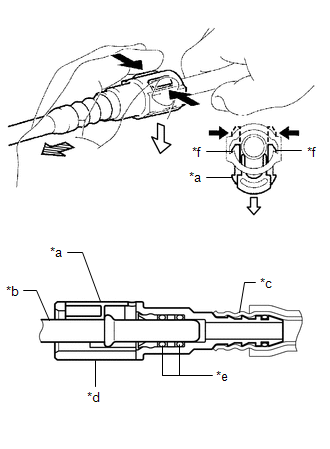
| *a | Retainer |
| *b | Fuel Pipe |
| *c | Nylon Tube |
| *d | Fuel Tube Connector |
| *e | O-ring |
| *f | Claw |
.png) | Push |
.png) | Pull out |
.png) | Pull off |
NOTICE:
Be sure to disconnect the fuel tube connector by hand.
(2) If the fuel tube connector and fuel pipe are stuck, push and pull the fuel tube connector to release it. Pull the fuel tube connector off of the fuel pipe carefully.
NOTICE:
- Be sure to disconnect the fuel tube connector by hand.
- Do not scratch or allow any foreign matter to get on the parts when disconnecting them as the fuel tube connector has O-rings that seal the pipe (fuel pipe).
- Do not bend, twist, pinch or kink the nylon tube.
(3) Check that there is no foreign matter on the sealing surfaces of the disconnected fuel lines. Clean them if necessary.
(4) Cover the disconnected fuel pipe and fuel tube connector with plastic bags to prevent damage and contamination.
(e) Quick Type B:
Perform the following procedure when connecting a fuel tube connector.
NOTICE:
Check that there is no damage or foreign matter on the connecting parts of the fuel lines.
(1) Align the fuel tube connector with the fuel pipe, push the fuel tube connector onto the fuel pipe, then push in the retainer to engage the 2 claws.
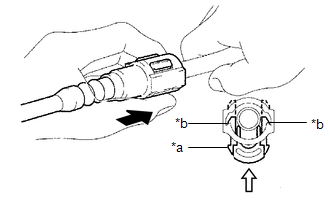
| *a | Retainer |
| *b | Claw |
.png) | Push |
.png) | Push in |
NOTICE:
Confirm that the retainer makes a "click" sound when pushed.
HINT:
If it is difficult to push the fuel tube connector onto the fuel pipe, apply a small amount of clean gasoline to the tip of the fuel pipe.
(2) After connecting the fuel lines, check that the fuel pipe and fuel tube connector are securely connected by pulling on them.
(3) Inspect for fuel leaks.
Click here .gif)
(f) Quick Type C:
Perform the following procedure when disconnecting a fuel tube connector.
NOTICE:
Remove any foreign matter on the fuel tube connector and fuel pipe before performing this work.
(1) Disengage the 2 claws of the retainer. Pull out the retainer and disconnect the fuel tube connector from the fuel pipe.
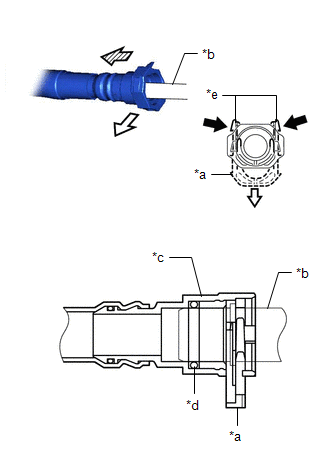
| *a | Retainer |
| *b | Fuel Pipe |
| *c | Fuel Tube Connector |
| *d | O-ring |
| *e | Claw |
.png) | Push |
.png) | Pull out |
.png) | Pull off |
NOTICE:
Be sure to disconnect the fuel tube connector by hand.
(2) If the fuel tube connector and fuel pipe are stuck, push and pull the fuel tube connector to release it. Pull the fuel tube connector off of the fuel pipe carefully.
NOTICE:
- Be sure to disconnect the fuel tube connector by hand.
- Do not scratch or allow any foreign matter to get on the parts when disconnecting them as the fuel tube connector has an O-ring that seals the pipe (fuel pipe).
(3) Check that there is no foreign matter on the sealing surfaces of the disconnected fuel lines. Clean them if necessary.
(4) Cover the disconnected fuel pipe and fuel tube connector with plastic bags to prevent damage and contamination.
(g) Quick Type C:
Perform the following procedure when connecting a fuel tube connector.
NOTICE:
Check that there is no damage or foreign matter on the connecting parts of the fuel lines.
(1) Align the fuel tube connector with the fuel pipe, push the fuel tube connector onto the fuel pipe, then push in the retainer to engage the 2 claws.
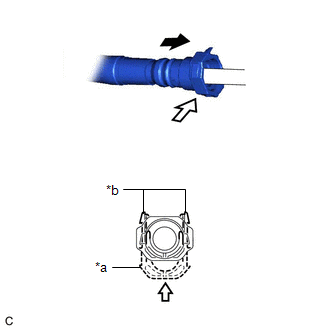
| *a | Retainer |
| *b | Claw |
.png) | Push |
.png) | Push in |
NOTICE:
Confirm that the retainer makes a "click" sound when pushed.
HINT:
If it is difficult to push the fuel tube connector onto the fuel pipe, apply a small amount of clean gasoline to the tip of the fuel pipe.
(2) After connecting the fuel lines, check that the fuel pipe and fuel tube connector are securely connected by pulling on them.
(3) Inspect for fuel leaks.
Click here .gif)
(h) Observe the following precautions when handling a nylon tube:
NOTICE:
- Do not twist the nylon tube of the fuel tube connector or fuel tube connector when connecting it.
- Do not remove the Ethylene Propylene Diene Monomer (EPDM) rubber protector on the outside of the nylon tube.
- Do not bend, twist, pinch or kink the nylon tube.
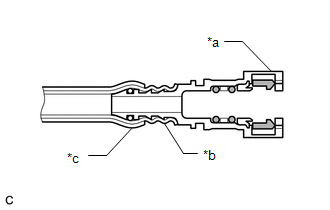
| *a | Fuel Tube Connector |
| *b | Nylon Tube |
| *c | Ethylene Propylene Diene Monomer (EPDM) Rubber Protector |
FUEL SUCTION TUBE WITH PUMP AND GAUGE ASSEMBLY
NOTICE:
-
Do not disconnect the tube shown in the illustration when disassembling the fuel suction tube with pump and gauge assembly. Doing so will cause reassembly of the fuel suction tube with pump and gauge assembly to be impossible as the tube is pressed into the fuel suction plate sub-assembly.
.png)
*A
for TMC Made
*B
for TMMC Made
*a
Tube
- When replacing the fuel filter, replace it together with the fuel suction plate sub-assembly.
INSPECT FOR FUEL LEAK
(a) Check that there are no fuel leaks from the fuel system after doing any maintenance or repairs.
Click here .gif)
 Parts Location
Parts Location
PARTS LOCATION ILLUSTRATION *A w/ Rear No. 2 Seat *B w/o Rear No. 2 Seat *1 FUEL SENDER GAUGE ASSEMBLY *2 FUEL PUMP (for Low Pressure) *3 FUEL PUMP CONTROL ECU ASSEMBLY *4 ...
 System Diagram
System Diagram
SYSTEM DIAGRAM FUEL FLOW DIAGRAM *A for Direct Injection - - *1 Fuel Injector Assembly *2 Throttle Body with Motor Assembly *3 Fuel Pressure Sensor (for High Pressure) *4 ...
Other materials:
Lexus RX (RX 350L, RX450h) 2016-2025 Repair Manual > Sfi System: Diagnostic Trouble Code Chart
DIAGNOSTIC TROUBLE CODE CHART SFI System DTC No. Detection Item MIL Memory Note Link P001013 A Camshaft Position Actuator Bank 1 Circuit Open Comes on DTC stored SAE Code: P0010 P001100 Camshaft Position "A" - Timing Over-Advanced or System Performance Bank 1 Co ...
Lexus RX (RX 350L, RX450h) 2016-2025 Repair Manual > Seat Heater Switch (for Rear Side): Components
COMPONENTS ILLUSTRATION *A for Console Box - - *1 CONSOLE REAR END PANEL SUB-ASSEMBLY *2 REFRESHING SEAT SWITCH ILLUSTRATION *A for Armrest - - *1 ARMREST ASSEMBLY *2 CENTER ARMREST HINGE COVER LH *3 NO. 1 SEAT ARMREST ASSEMBLY *4 REAR SEATBACK BO ...
Lexus RX (RX 350L, RX450h) 2016-{YEAR} Owners Manual
- For your information
- Pictorial index
- For safety and security
- Instrument cluster
- Operation of each component
- Driving
- Lexus Display Audio system
- Interior features
- Maintenance and care
- When trouble arises
- Vehicle specifications
- For owners
Lexus RX (RX 350L, RX450h) 2016-{YEAR} Repair Manual
0.0095
